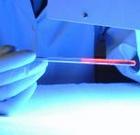 Red light from carbon nanotubes
Red light from carbon nanotubes
Method developed with the participation of the Institute of Physical Chemistry PAS allows to obtain nanotubes, which glow red. They can be used, for example, for particle detection.
According to the Institute of Physical Chemistry PAS, the effective method of producing new photonic material: carbon
nanotubes coated with complexes of compounds capable of illumination in
red, has been developed by scientists working within the international
project FINELUMEN. It is coordinated by Dr. Nicola Armaroli from the
Istituto per la Sintesi Organica e la Fotoreattivita, Consiglio
Nazionale delle Ricerche (CNR-ISOF) in Bologna.
"We participate
in the project as a group specializing in the research into lanthanide
compounds. We decided to combine their exceptional emission properties
with excellent mechanical and electrical properties of nanotubes" -
explaind Prof. Marek Pietraszkiewicz from the Institute of Physical
Chemistry PAS in Warsaw.
The Institute representatives explained
that carbon nanotubes can be imagined as rolled up sheets of graphite.
Usually they look like black powder. It is difficult to make them emit
light, because they are very conductive and capture the energy of others
molecules capable of emitting light, placed in their vicinity.
Lateral
surface of each nanotube is relatively large and allows the attachment
of many other molecules, including those emitting light. "Attaching
light-emitting complexes directly to the nanotube is not useful, because
the nanotube, as a black absorber, would suppress luminescence" -
explained Valentina Utochnikova, PhD student at the Institute of
Physical Chemistry PAS.
"To reduce the undesirable light
absorption effect, nanotubes are first subjected to a thermal reaction
at a temperature of 140-160 degrees Celsius in a solution of ionic
liquid modified with azide group. As a result of the reaction, the
nanotubes are coated with molecules that act as anchors, connectors.
Anchors attach to the surface of nanotubes on one side, on the other
they can attach molecule capable of emitting visible light. The free end
of each connector has a positive charge" - according to the release.
So
prepared nanotubes are transferred to another solution containing
negatively charged lanthanide complex -
tetrakis-(4,4,4-trifluoro-1-(2-naphthyl-1 ,3-butanodionian) europium.
"Lanthanide compounds, which contain elements of group 4 of the periodic
table, are very attractive for photonics, as they exhibit high quantum
lighting effectiveness and high colour purity of emitted light"
-emphasized Utochnikova.
Researchers from the Institute explained
that after being dissolved in a solution, negatively charged complexes
of europium through electrostatic interaction are intrinsically captured
by the positively charged free ends of the anchors on the nanotubes.
As a result of the process, each nanotube is permanently covered with
molecules capable of emitting visible light. When the reaction is
complete, modified nanotubes are washed and dried. The final product is
black powder. However, under ultraviolet radiation the lanthanide
complexes anchored to nanotubes begin to glow red.
The concept of
modification of carbon nanotubes and the substrates - ionic liquid and
lanthanide complex for coating carbon nanotubes - have developed by the
team of Prof. Pietraszkiewicz at the Institute of Physical Chemistry
PAS, while modifications of nanotubes and spectral analysis have been
performed by research teams from the University of Namur in Belgium and
the CNR-ISOF Institute in Bologna.
"Importantly, the chemical
reactions used to obtain new luminescent nanotubes proved to be much
simpler to implement than those previously used" - emphasised the press
release.
Furthermore, the resulting photonic material can be
used, for example, for the detection of molecules, including biological
ones.
"Identification would take place by analysing the changes
of light emitted by nanotubes after deposition of molecules of test
substances. Good electrical conductivity in combination with efficient
lighting nanotube make an attractive new material also for technologies
based on electroluminescent organic light emitting diodes OLED" - said
the representatives of the Institute of Physical Chemistry PAS.
International
FINELUMEN project is implemented as part of the initial training of
researchers Marie Curie Initial Training Networks, operating within the
7th Framework Programme of the European Union. (PAP)
last modification: 2011-07-25













































 Red light from carbon nanotubes
Red light from carbon nanotubes